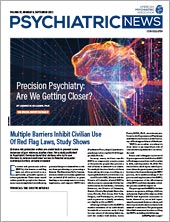When Andrea Spencer, M.D., speaks with Black families of children with attention-deficit/hyperactivity disorder (ADHD) about their experiences engaging in ADHD care, she often hears the same word: Dismissed.
“You can see it in the numbers, but it’s even easier to see in clinical practice: Some patients just get more comprehensive care than others,” Spencer said. “There are stark disparities in the care patients experience, including socioeconomic disparities, linguistic disparities, and race or ethnicity disparities.”
Spencer runs the Revolutionizing Equal Access to Care and Health for ADHD (REACH) program at Boston Medical Center. There, she and her colleagues examine the barriers and stigma that minority families face when seeking care for their children with ADHD. They are currently conducting a study to investigate whether the ADHD stigma that families report is linked to the rising rates of suicide among Black children with ADHD.
A study published in October 2016 in Pediatrics led by Arielle Sheftall, Ph.D., found that ADHD is the most common psychiatric illness associated with suicide among elementary school–aged children. Though suicide among young children is exceedingly rare, Black children under age 13 are twice as likely to die by suicide compared with their White peers, according to the National Institute of Mental Health. The suicide death rate among Black youth has also been increasing faster than in other racial/ethnic groups. Sheftall is a principal investigator in the Center for Suicide Prevention and Research at the Abigail Wexner Research Institute at Nationwide Children’s Hospital.
Black children with ADHD may experience both racial discrimination and ADHD-related stigma, Spencer explained. Through their study, Spencer said she and her colleagues are hoping to better understand potential population-specific suicide prevention strategies, as well as to examine the relationship between discrimination, ADHD, and suicidal behavior. The study is in the recruitment phase, and she expects to have data sometime in 2023.
The study grew out of previous research Spencer has conducted with REACH, particularly studies that largely rely on qualitative research. “I learn a lot by analyzing the in-depth interviews from my own studies. This research modality can provide a really rich level of information from families to inform the field,” she said.
One such study involved interviews about engagement with care and involved asking families about what helped them access, remain in, and benefit from care for their children with ADHD. Spencer and her colleagues used their findings to outline the stages of engagement with care, which they published in Pediatrics in October 2021. About 58% of the study sample were African American families, and 39% were Hispanic, Latino, or of Spanish origin.
The study illuminated how difficult it is for minority families to approach physicians and explain that they suspect their child has ADHD, Spencer said. Some worry the physician will suspect something is wrong at home and alert child protective services. Some feel pressure from their community members, who may not believe ADHD is real. To compound the problem, after overcoming these barriers, some parents are still faced with skepticism from physicians when they share their concerns, and some reported that physicians listened to their concerns only when their children’s symptoms had worsened.
The stigma and discrimination families experienced ultimately delayed them from seeking care, which meant that children all too often reached a crisis point before they received the treatment they needed.
“I realized that the complexity of the interaction between forms of provider bias and community stigma around ADHD compounds the difficulties these families experience,” Spencer said. “As I analyzed the data, I learned about all the work being done to understand suicide disparities.”
Sheftall, who led the 2016 study linking ADHD and suicide, told Psychiatric News that a great deal more research needs to be done that explores the link between suicidal behavior and ADHD, and she agreed with Spencer’s hypothesis that both racism and ADHD-related stigma likely play a role.
She is also involved in studies looking into the connection between ADHD and suicidal ideation and attempts. One study is investigating how ADHD symptomology is associated with suicidal behavior, particularly within the high-risk group of children whose parents died by suicide or attempted suicide. In another study, she and her colleagues are trying to determine whether certain symptoms associated with an ADHD diagnosis are also associated with suicidal ideation or behaviors.
The impulsivity associated with ADHD may increase the risk of children with the disorder to act on suicidal thoughts when they arise, Sheftall explained. Additionally, the discrimination that Black families experience can create the perfect storm when a child has ADHD.
“We know, unfortunately, when it comes to mental health concerns and treatment, there is a huge racial disparity,” she said. “Between the Black community’s lack of trust in the medical system because of the past experiences they and their family members have had and biases among providers, kids aren’t getting the treatment they seriously need.
“The good news—if there is any good news—is that there is potential to start interventions in this younger age group now,” Sheftall continued. “In primary care facilities, we can really start educating physicians about ADHD and suicidal behavior, as well as institute more screenings during appointments.” Parents, teachers, coaches, and anyone who comes in contact with young children can and should also be educated as well, she said. “It is unfortunate where we are right now, but we do have some insight into where prevention can occur and what action must be done.” ■


